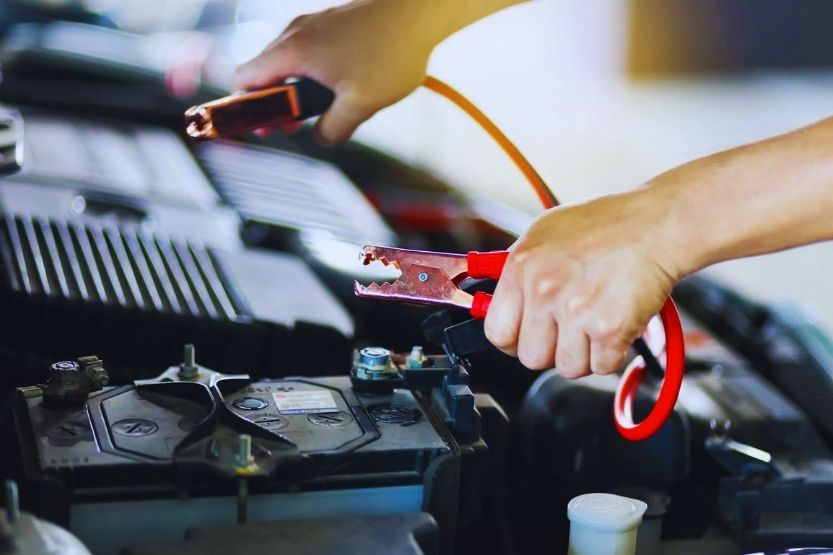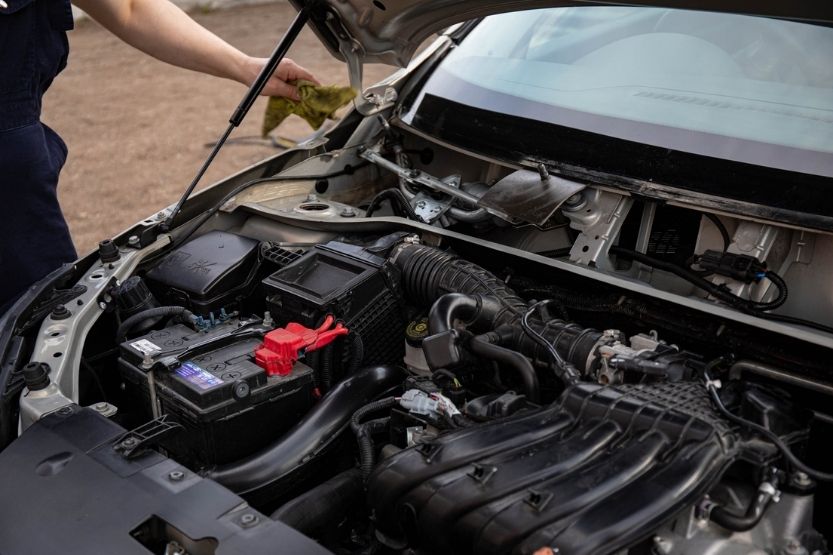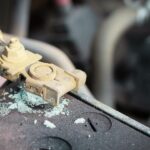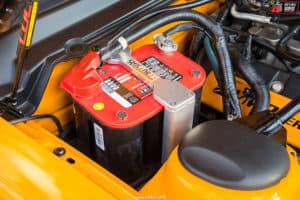If you don’t know enough about a car battery, you may assume that the positive sign on the red cable means it is the positive terminal. What if the terminals of the battery have no colors? This article will discuss the battery’s positive and negative color – how a car battery works.
Car batteries always have two terminals. One is positive, and another is negative. Usually, the positive terminal is red, while the negative terminal is black. You should never connect the red cable of a jumper cable to the negative battery terminal but only to the positive terminal.
Most terminals of car batteries are color-coded. Red is usually associated with the plus (+) sign, the battery’s positive terminal.
Black is typically used to identify the minus (-) sign or negative terminal of the battery. The negative terminal is the one that is connected to the vehicle’s metal chassis or engine block.
Read on to learn more about a car battery’s positive and negative colors and how a battery works.
Battery Positive Color and Negative Color

Car Batteries Have Positive and Negative Terminals
All car batteries have positive and negative terminals. Typically, the positive terminal has a plus sign and is red. So, red is the car battery’s positive color. The negative terminal usually has a minus sign and is black. It is the car battery’s negative side.
Do Not Connect the Jumper’s Red Cable to the Dead Battery’s Black Terminal
If you are reviving a dead battery, you should not connect the red cable of the jumper set to the negative or black terminal of the dead battery.
Easily Identify the Car Battery’s Positive and Negative Sides
By knowing the usual colors that represent the terminals of a car battery, you will easily identify the car battery’s positive and negative sides.
So, red indicates the positive terminal, while black is the negative terminal. The black or negative terminal is connected to the vehicle’s metal chassis.
What Is a Battery
A Device That Transforms Chemical Energy into Electricity
National Aeronautics and Space Administration (NASA) has a neat definition of a battery. They say it is a device that transforms chemical energy into electricity. Inside a battery are several cells. The actual energy that the battery produces is contained in these cells.
Stores Chemical Energy
Also, a battery is an electrical device that stores chemical energy and then transforms that same energy into electricity on command. Batteries are the source of electricity that power the electronic devices in your car, including the starting motor or alternator.
Use a Lead-acid Chemical Reaction to Power Electric Devices
Most car batteries use a lead-acid chemical reaction to power the electric devices used inside automobiles. These batteries are classified as SLI batteries. SLI means starting, lighting, and ignition.
Provide Short Bursts of Electricity to Energize the Engine
Batteries primarily provide short bursts of electricity to energize the engine, together with its lights and accessories. Once the battery has fulfilled its role, the job of supplying power or electricity to all the vehicle’s electrical components is taken over by the car’s alternator.
How Does a Battery Work
Standard SLI Battery Has Six Cells
A standard SLI battery contains six cells. Every cell has two plates or grids. One of the plates is lead while the other is lead oxide. Every cell can produce around two volts of electricity. So, if there are six cells in a battery, each battery can produce 12 volts. That’s why people call them 12-volt batteries.
Sulphuric Acid Acts as a Catalyst
The metal plates are submerged in sulphuric acid. This chemical substance acts as a catalyst that triggers a chemical reaction between the two plates. This reaction produces two substances: lead sulfate and ions.
The ions that came out of the lead dioxide plate react to the nearby plate which then produces lead sulfate and hydrogen.
Generation of Electricity
This will result in a chemical reaction that generates electrons. These electrons travel fast around the plates. This results in the generation of electricity.
The electricity goes out of the battery terminals so you can:
- Start the engine,
- Turn on the headlights,
- Play the radio, and
- Supply electricity to the car’s other electrical devices.
The battery’s chemical reaction is completely reversible. This is the reason why it is possible for you to jumpstart a dead battery. It also explains its ability to be recharged in the entirety of its life.
If you will apply just the right amount of voltage, lead and lead dioxide will develop on the plates. So, you will be able to continue using your battery again.
More on Car Battery’s Positive and Negative Terminals
At present, almost all car batteries have terminals with either a plus or a minus sign. Most of these car batteries will also have one red terminal. That helps to identify which of the two terminals in a battery is positive and negative.
The following tips will help you better understand and identify a car battery’s positive and negative terminals:
1. Look at the Printed Symbols
Every battery has signs or symbols printed near or on its terminals. Looking at these signs is one of the ways you can identify if the terminal is positive or negative.
If the terminal has a plus (+) symbol printed near it or on top of it, it is the positive terminal. The car battery positive cable should be connected to it. If the print is a minus (-) sign, it is the negative terminal.
2. Check the Terminals’ Diameters
The size or diameter of the battery terminals will also tell you if it is the positive or the negative terminal. In most car batteries, the terminal with a larger diameter is the positive terminal. This is true even for European and Japanese cars.
Terminal with Larger Diameter Is Usually the Positive One
So, the terminal with a smaller diameter is the negative terminal. From a distance, the sizes of both terminals may look the same. But when you take a closer look, most surely, you will notice that one terminal is bigger than the other.
3. Colors
There are some batteries with color-coded terminals. If you have this kind of battery, it will be easy to identify the positive and negative. The industry standard is that red is the color of the positive terminal, and black is the color of the negative terminal.
So, even if the symbols are faded, you can still identify them through their colors.
Reason Behind the Color of Car Battery Terminals

Red Is Associated with Danger
Why did they choose red for the positive terminal and black for the negative terminal? The basic reason is that red means danger. So, they used red for the positive terminals of car batteries so that car owners and drivers would be more careful when working with their batteries.
For instance, if we want to remove an old battery from a car, we must first disconnect the cables from the negative terminal. For the majority of vehicles, this is the terminal with black color. Only then will it be safe for you to disconnect the positive terminal, which is the one with the red color.
Is It Positive or Negative First When Connecting a Battery?
There’s a warning not to connect the red cable to the negative terminal of a dead battery. That is dangerous if you do. So, red is for the positive terminal and black for the negative terminal to avoid confusion and prevent accidents.
As you can see, knowing the identity of the terminals is very important when trying to jump-start a dead battery using the working battery of another vehicle. If you see the difference, there is no way you can wrongly hook up the connections of the two batteries.
Batteries with Blue and Red Terminals
Some batteries have blue and red terminals. Red is still the positive terminal in these battery types, and blue is the negative terminal. Experts always use red in most types of vehicle batteries to avoid confusion. The red color indicates that it is the battery’s positive terminal.
Again, what color is negative and what color is positive on a battery? A battery has two terminals: one is positive (+; red) and the other negative (-; black or blue). Note that a jumper cable set also has positive and negative cables.
How About an Unmarked Car Battery?
Now, you will ask, how about car batteries with no plus or minus signs or symbols? Some car batteries have terminals that are neither black nor red.
Look at the Terminals’ Size
How can you tell which is which? It’s not that difficult because there is a simple way to do it. Look at the sizes of the two terminals.
If you look at them closely, you will notice that one is bigger than the other. Most of the car batteries sold in the market are like this. The size or the diameter of one terminal is bigger than the diameter or size of the other terminal.
Positive Terminal Is Bigger
In these batteries, the bigger terminal is usually the positive terminal. That makes the smaller one the negative terminal. If you remember their size difference, it will be easy to identify.
How to Jump Start Your Car
One of the reasons you need to be sure which is the positive and the negative terminal in your car battery is when it suddenly goes dead, and you need to jump-start it. You have to connect the right wiring of the jump-starting cable to avoid an electrical accident and revive your dead battery.
So, how can you safely do it? First, you need a good working battery from another car and a jumper cable set.
Here are the steps you can safely follow:
- Park the other car with a fully charged and working battery near your car with its dead battery.
- Now, connect one end of the red jumper cable first to the positive terminal of the working battery and its other end to the positive terminal your dead battery.
- Connect one end of the black jumper cable to the negative terminal of the good battery and its other end to the metal ground used by your dead battery. It could be any part of the engine block or the chassis of your vehicle as long as it is not very near to the dead battery.
- Start the engine of the car with the working battery and leave it idling for a few minutes.
- Now, start the engine of your car. With the jumper cable still attached to both batteries, leave your car idling for a few minutes.
- Now that your car is already running, start to remove the jumper cable in reverse.
- The first cable that you need to remove is the black jumper cable. Remove the end connected to your car before you remove the end connected to the other car.
- Then remove the red jumper cable. Remove the end connected to your car with the fully charged battery before you remove the end connected to the positive terminal of your car.
- With your car still idling, hopefully, you revived your battery.
- If the alternator of your car is working well, it should recharge the battery in no time.
- Fully charge your battery after you jump start it.
Frequently Asked Questions

How Do You Differentiate the Positive Terminal from the Negative Terminal of a Battery?
Most batteries have red and black terminals. The red terminal is the positive side of the battery, and the black or uncolored terminal is its negative side.
You will also see some markings on the side of the terminals themselves in some batteries. It is positive if you see a plus (+) symbol on the terminal. But if the sign is a minus (-), that terminal is the negative side of the battery.
How Can You Tell If the Battery Terminal Is Negative?
If you see a cable with a black color connected to a battery, that terminal is the negative terminal of that battery. You will see a red cable connected to the other terminal on the other side. That is the positive terminal of that battery.
It is confusing to see cables with faded colors. In that case, use the rule of thumb, which says if the color of the cable is more intense than the other, that is the battery’s positive terminal.
In other words, the cable with a less color hue is connected to the battery’s negative terminal.
What Is the Color of the Wire That You Should Connect First on a Car Battery?
Some say that you should connect the positive wire first. However, there are battery experts who disagree.
If you want to connect a charged battery, you should first connect the negative or the black cable before the positive or red cable.
Experts say this is due to the current’s flow, which runs from the ground through your body while holding the wire. If you connect the positive or red cable first, the voltage difference between your hands will send you an electric shock.
What Is the Negative Side of a Battery?
The negative side of a car battery is usually connected to the car chassis to make a ground connection. Most of the wires connected to the positive side of batteries are colored black.
What Is the Plus Side of a Battery?
The positive side of a battery has an input and an output. The input draws power from the battery, and the output provides power to the vehicle’s electrical components.
Why Is the Positive Cable and Terminal Colored Red?
Red means danger. So, don’t connect it carelessly with other wires. Note that you shouldn’t connect it to the negative cable.
If you do, this will result in a short circuit that can lead to an explosion if you do. Anything can happen in an exploding battery.
Why Disconnect the Negative or Black Cable First?
You should disconnect the negative cable when removing a battery. If you remove the positive first in an electric circuit, you run the risk of a short circuit. It’s also related to how a car operates.
Ultimately, the car engine should be connected to the battery, which has two terminals for it to work. It is hooked up by cables where the current flows directly from the positive terminal to the negative terminal.
You don’t need any other wiring network since the energy flows freely and directly from one terminal to the other without any interference across the engine block.
So, if you remove the negative wire first, there will be no effect on the current flow because there are no other wires or paths where the current can flow.
It can only flow to the negative side, which will not happen since you have already disconnected it. But if you disconnect or remove the positive or red cable first, the existing circuit will lose its flow of electricity. It could even lead to a short circuit.
This is a very simplified way of explaining it. You also need to consider other factors in the real world.
How Do You Connect a Jump Start Cable to a Dead Battery?
Connect one end of the red cable of the jump-start kit to the red terminal of the fully charged battery. Then connect its other end to the red or positive terminal of the dead battery.
Get the black cable of the jump start kit and connect one of its ends to the negative terminal of the fully charged battery. And then connect its other end to the engine block or the vehicle’s metal chassis with the dead battery. Choose a connection that is not so close to the dead battery.
Conclusion: Battery Positive Color and Negative Color Words
There are always two terminals in car batteries. One of these terminals is positive, while the other is negative. Typically, the positive terminal has a plus sign, and the negative terminal has a minus sign.
When using a jumper cable set to revive a dead battery, don’t connect the red cable of the jumper to the negative or black terminal of the battery.
The majority of car batteries are color-coded. The terminal with a plus sign, the positive terminal, is colored red, while the terminal with a minus sign or the negative terminal is colored black. It is the negative terminal connected to the car’s metal chassis.
Read next:



![Costco Tire Warranty [How It Works and What It Covers] Costco Tire warranty](https://roadsumo.com/wp-content/uploads/2021/05/Costco-tire-warranty-150x150.png)
![Walmart Tire Warranty [How It Works and What It Covers] Walmart Tire Warranty](https://roadsumo.com/wp-content/uploads/2021/12/Walmart-tire-warranty-150x150.jpg)




